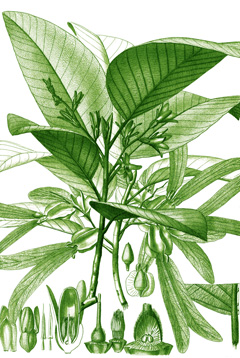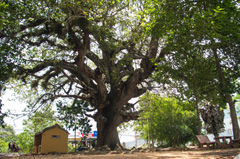 |
|
https://edibleplants.org/ |
 |
| https://edibleplants.org/ |
Translate this page:
Summary
Dipterocarpus alatus or commonly known as Apitong is a tropical forest tree that can be found in Thailand, Cambodia, Laos, Vietnam, and the Philippines. It is medium-sized of about 40 m in height with an umbrella-shaped canopy and a tall, straight, cylindrical trunk that can be up to 150 cm in diameter. Considered as an endangered species, the tree produces a highly valued wood in construction and oily resin. The trunk yields resin that can be used in analgesic liniments or as an antiseptic in bandages on ulcerated wood (when mixed with bee wax). It can also be used for illumination and waterproofing baskets and bots, for paint, as varnish, and in printing ink industries. The bark can be used against rheumatism and liver diseases. The plant also yields essential oil used in perfumery. The wood is hard, fine-grained, but not very durable.
Physical Characteristics

 Dipterocarpus alatus is an evergreen Tree growing to 30 m (98ft) by 20 m (65ft) at a slow rate.
Dipterocarpus alatus is an evergreen Tree growing to 30 m (98ft) by 20 m (65ft) at a slow rate.
See above for USDA hardiness. It is hardy to UK zone 10.
Suitable for: light (sandy), medium (loamy) and heavy (clay) soils and prefers well-drained soil. Suitable pH: mildly acid, neutral and basic (mildly alkaline) soils. It can grow in semi-shade (light woodland) or no shade. It prefers moist soil.
UK Hardiness Map
US Hardiness Map
Synonyms
Dipterocarpus gonopterus Turcz. Dipterocarpus incanus Roxb. Dipterocarpus lemeslei Vesque Dipterocar
Plant Habitats
Edible Uses
References More on Edible Uses
Medicinal Uses
Plants For A Future can not take any responsibility for any adverse effects from the use of plants. Always seek advice from a professional before using a plant medicinally.
Analgesic Antirheumatic Antiseptic Disinfectant Diuretic Hepatic Laxative Stimulant
The resin obtained from the trunk is disinfectant, laxative, diuretic, mildly stimulant. It is used in analgesic liniments and can be mixed with bee wax then used as an antiseptic in bandages on ulcerated wounds[ 404 ]. The bark of the young tree, provided with 2 - 4 leaves, is believed to have medicinal virtues against rheumatism and diseases of the liver[ 404 ].
References More on Medicinal Uses
The Bookshop: Edible Plant Books
Our Latest books on Perennial Plants For Food Forests and Permaculture Gardens in paperback or digital formats.

Edible Tropical Plants
Food Forest Plants for Hotter Conditions: 250+ Plants For Tropical Food Forests & Permaculture Gardens.
More

Edible Temperate Plants
Plants for Your Food Forest: 500 Plants for Temperate Food Forests & Permaculture Gardens.
More

More Books
PFAF have eight books available in paperback and digital formats. Browse the shop for more information.
Shop Now
Other Uses
Charcoal Containers Cosmetic Disinfectant Essential Fuel Furniture Ink Lighting Paint Pioneer Resin Soil conditioner Varnish Waterproofing Wood
Agroforestry Uses: The tree is a rapid colonizer of alluvial soils along the sides of rivers - it is used as a pioneer in forestry planting schemes to restore wasteland and establish woodlands[ 303 , 320 ]. The tree is used as a soil improver[ 303 ]. The organic matter and NPK content of soils under the tree canopy have been shown to be higher than in soils further away from the tree[ 303 ]. The tree is commonly intercropped with fruit trees[ 404 ]. Other Uses: An oleoresin is obtained by tapping the tree[ 303 ]. Yields are good, but the resin is rather thin[ 146 , 439 ]. It is used by indigenous people for illumination and waterproofing baskets and boats[ 303 , 325 ]. Industrially, it is used for (zinc-based) paint; printing ink industries; varnish for walls and furniture; and lacquer; it can even be used as a fuel in diesel engines[ 303 , 404 ]. The resin is obtained by cutting a hole in the trunk near the base (about 90 - 150cm from the ground) and then dipping out the resin with a spoon as it collects there. To prolong the flow, a fire made from dead leaves or brushwood is made in the hole at intervals - this burns off the dried resinous film and allows the resin to flow again[ 64 , 146 ]. An essential oil, called yaang oil, is obtained from the plant. It is used as a fixative in perfumes[ 303 ]. The heartwood is reddish-gray; the sapwood white[ 146 ]. The wood is rather hard, fine-grained, easy to saw and polish[ 598 ]. It is not very durable in contact with the ground[ 418 ]. One of the most important commercial timber species, next to teak, in Thailand[ 303 ]. The wood is used for construction, railway sleepers, boats, pulp and a number of other purposes[ 325 , 598 ]. Because of its resinous nature, it is less suitable for flooring or being exposed to the sun[ 418 ]. The wood is used for fuel and to make charcoal[ 404 , 418 ]. The tree is an important source of keruing timber. In addition to the information above, a general description of keruing timber is as follows:- The heartwood is light red to red brown or purplish red brown; it is clearly demarcated from the 5 - 7cm wide band of sapwood. The texture is coarse; the grain straight or interlocked. The wood is moderately heavy to heavy; moderately hard; somewhat durable, being resistant to dry wood borers, fairly resistant to fungi but susceptible to termites. It seasons slowly, with a high risk of checking and distortion; once dry it is poorly stable to moderately stable in service. It has a high blunting effect on tools due to the presence of silica, stellite-tipped and tungsten carbide tools are recommended; some species are very resinous and can clog tools; there is occasional tearing on quartersawn wood; nailing and screwing are good, but require pre-boring; gluing is correct, but care is required because of the resin. A general construction timber, it is used in carpentry, panelling, joinery, floors, timber frame houses, boxes and crates, veneer etc[ 848 ].
Special Uses
Carbon Farming Food Forest
References More on Other Uses
Cultivation details
Industrial Crop: Hydrocarbon Management: Standard Wild Crop
A plant of the lowland tropics where it is found at elevations up to 500 metres[ 303 ]. It grows best in areas where annual daytime temperatures are within the range 22 - 32°c, though it can tolerate 10 - 36°c[ 418 ]. It can be killed at temperatures of 5°c[ 418 ]. According to one report, it prefers a mean annual rainfall of 1,100 - 2,200mm, uniformly spread through the year[ 325 ]. Another report says it has a preferred rainfall of 3,500 - 4,500mm, but can tolerate 3,000 - 5,200mm[ 418 ]. The plant, especially when young, is very tolerant to shade and seedlings can survive under heavy shade for years[ 325 ]. As trees grow older, they become more light-demanding[ 598 ]. Found mainly on alluvial soils in the wild[ 303 ]. Prefers a pH in the range 5 - 6.5, tolerating 4.5 - 7[ 418 ]. Members of this genus generally only regenerate naturally in the shade of the forest. Seedlings and saplings can persist in dense forest shade for many years. In their first 2 years the young plants cannot tolerate major openings in the canopy, but after they are well established (about 120cm tall) the canopy can be opened up around them to speed up their growth[ 404 ]. Annual production of oleoresin per tapped tree is between 23 and 31 litres[ 303 ]. Trees have a thin bark and are very sensitive to damage by fire[ 325 ].
Carbon Farming
-
Industrial Crop: Hydrocarbon
Materials, chemicals and energy include bioplastics, rubber, biomass products gasoline, jet fuel, diesel, butane, propane, biogas. Plants are usually resprouting plants and saps.
-
Management: Standard
Plants grow to their standard height. Harvest fruit, seeds, or other products. Non-Destructive management systems.
-
Wild Crop
Some wild plants have strong historical or contemporary use. Although they are not cultivated crops, they may be wild-managed.
References Carbon Farming Information and Carbon Sequestration Information
Temperature Converter
Type a value in the Celsius field to convert the value to Fahrenheit:
Fahrenheit:
The PFAF Bookshop
Plants For A Future have a number of books available in paperback and digital form. Book titles include Edible Plants, Edible Perennials, Edible Trees,Edible Shrubs, Woodland Gardening, and Temperate Food Forest Plants. Our new book is Food Forest Plants For Hotter Conditions (Tropical and Sub-Tropical).
Shop Now
Plant Propagation
Seed - it has a short viability and so should be sown as soon as it is ripe[ 325 ]. No pre-treatment is required. Sow the seeds in a nursery seedbed, germination usually commences within 4 - 7 days at 25°c[ 303 , 325 ]. Seedlings are ready to plant out when they are 30cm tall, which takes about 8 - 12 months[ 325 ]. Seed storage behaviour is intermediate, the lowest safe moisture content is 17 %, no seeds survive further desiccation to 8 % moisture content[ 303 ]. At 12 % moisture content, only 36 % germination occurred after 939 days hermetic storage at -18°c compared to 80 % viability before storage[ 303 ]. Cuttings taken from coppice shoots produced after hedging rooted successfully with 44.5% rooting, indicating the potential for mass production of rooted cuttings from hedge orchards[ 303 ].
Other Names
If available other names are mentioned here
baume de gurjun, gurjun balsam, hairy-leaf apitong
Native Range
TROPICAL ASIA: Bangladesh, Cambodia, Laos, Myanmar, Thailand, Vietnam, Philippines (Luzon (possibly native))
Weed Potential
Right plant wrong place. We are currently updating this section.
Please note that a plant may be invasive in one area but may not in your area so it's worth checking.
Conservation Status
IUCN Red List of Threatened Plants Status : Status: Endangered A1cd+2cd, B1+2c

Growth: S = slow M = medium F = fast. Soil: L = light (sandy) M = medium H = heavy (clay). pH: A = acid N = neutral B = basic (alkaline). Shade: F = full shade S = semi-shade N = no shade. Moisture: D = dry M = Moist We = wet Wa = water.
Now available:
Food Forest Plants for Mediterranean Conditions
350+ Perennial Plants For Mediterranean and Drier Food Forests and Permaculture Gardens.
[Paperback and eBook]
This is the third in Plants For A Future's series of plant guides for food forests tailored to
specific climate zones. Following volumes on temperate and tropical ecosystems, this book focuses
on species suited to Mediterranean conditions—regions with hot, dry summers and cool, wet winters,
often facing the added challenge of climate change.
Read More
Expert comment
Author
Roxb. ex G.Don
Botanical References
Links / References
For a list of references used on this page please go here
A special thanks to Ken Fern for some of the information used on this page.
Readers comment
| Add a comment |
|
If you have important information about this plant that may help other users please add a comment or link below. Only comments or links that are felt to be directly relevant to a plant will be included. If you think a comment/link or information contained on this page is inaccurate or misleading we would welcome your feedback at [email protected]. If you have questions about a plant please use the Forum on this website as we do not have the resources to answer questions ourselves.
* Please note: the comments by website users are not necessarily those held by PFAF and may give misleading or inaccurate information.
To leave a comment please Register or login here All comments need to be approved so will not appear immediately.
|
Subject : Dipterocarpus alatus
|
|
|
|